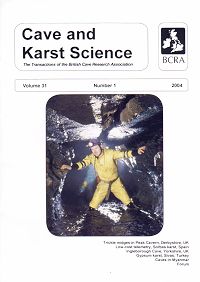 |
- Trickle midges in Peak Cavern, Derbyshire, UK
- Low-cost telemetry, Sorbas karst, Spain
- Ingleborough Cave, Yorkshire, UK
- Gypsum karst, Sivas, Turkey
- Caves in Myanmar
- Forum
Cover photo by John
Cordingly, assisted by Adrian Hall and Gerald Benn
Adrian Hall straddles
the joint-guided fissure at the head of Lake Avernus in Ingleborough Cave,
North Yorkshire. This spot, which provides a somewhat aqueous dive base for the
submerged connection with Beck Head Stream Cave, is reached by crawling in the
stream (Fell Beck) in a dangerously flood-liable area below Giant's Hall. The
first explorers arrived here almost 167 years ago with little better equipment
than old clothes and a few candles: a remarkable achievement [see also the
paper by Stephen Craven in this Issue]. |

